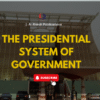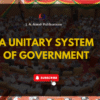PARLIAMENTARY/CABINET SYSTEM OF GOVERNMENT
OVERVIEW
A Cabinet or Parliamentary system of government is that type of system in which the Executive arm of government emanates from the Legislature and owes it legitimate existence to the Legislature. All the members of the Executive are selected from the Legislature and are ultimately answerable to it. States that practise the Parliamentary system include Britain, Canada, Australia and Ghana under the 1969 Constitution.
FEATURES OF THE CABINET/PARLIAMENTARY SYSTEM
1. Bicephalous/dual Executive: The Cabinet system of government operates the dual Executive. It is also called the bicephalous Executive. It means, the Executive is headed by two persons, that is, a Head of State who performs the ceremonial functions and a Head of Government who performs the governmental functions.
2. Fusion of powers: The Parliamentary system is grounded in the concept of fusion of powers between the Executive and the Legislature. What this means is that the members of the executive are at the same time, members of the Legislature. At elections, members of Parliament are elected directly by the electorates into the Legislature. The leader of the majority party in Parliament then becomes the Prime Minister who then chooses members from his party to form the government of the day.
3. Collective responsibility to the Legislature: Another feature is that the members of the Executive arm of government are made responsible and accountable to the Legislature for anything that goes wrong. They could be forced to collectively resign where they no longer enjoy the support of the Legislature. This happened in 2022 when Prime Minister Boris Johnson and his cabinet resigned.
4. No fixed term of office for the Executive: Dissimilar to the Presidential system where the Executive has a fixed term of office, in the Parliamentary system, the Executive does not have any fixed term of office. If it no longer has the full support of the Legislature, they latter may pass a vote of no confidence for the entire Cabinet to step down.
5. Official opposition: The system likewise boasts of the official recognition of an official opposition. The official opposition has two main duties. One is to put the ruling government on its toes by monitoring its work so that it does not deviate from its core mandate. The second one is to serve as a government in waiting so that when the need arises, it could be called to form the next government.
6. Strong party discipline: Party discipline is a critical matter in a Cabinet system of government. In fact, it is comparatively solid. Members of Parliament are not expected to deviate from the goals and policies of their party. They are not allowed to openly criticise their party. Any Member of Parliament who falls out of line is whipped back into line.
7. Supremacy of Parliament: This system operates under the principle that Parliament is supreme. This means the Parliament has the power to do anything and nobody has the power to stop it.
MERITS OF THE PARLIAMENTARY/CABINET SYSTEM
1. It lessens the workload: In this system, there is a dual Executive: there is a Head of State and Head of Government. It is not difficult for the two Executives to share the functions of the Executive between themselves. The sharing of the workload makes the work less tedious for the two of them.
2. It ensures continuity in government: Where there is a change in government, the Head of State does not leave office. Only the head of government does, with his whole government. The benefit is that, there is someone to hold the state together until a new government is formed. It then guarantees that there is a peaceful transfer of power from one government to another.
3. Loyalty to the state: The position of the Head of State is non-partisan or, at least, expected to be. Accordingly, the Head of State is an embodiment of the states. For this reason, the citizens tend to be loyal to the Head of State who symbolises the state.
4. Less likely to become tyrannical: One of the traits of a Cabinet system of government is the existence of an official opposition. One of the main responsibilities of the opposition is to keep the government in check. As soon as the government is kept in check, the leader is less likely to degenerate into a tyrant. Another feature of the system that helps to prevent tyranny is the dual Executive. The both act as a check on each other thereby foiling the rise of tyranny.
5. It is cheaper to operate: In a Cabinet system of government, the Parliamentary candidates compete for the seats in their constituency and after that the party that wins the majority seat is asked to form the next government led by the Prime Minister. The advantage is that there is only one level of election and therefore less spending to incur.
6. It guarantees responsible governance: In a Parliamentary system, the entire cabinet is collectively responsible to Parliament for all their actions. Parliament is a representative of the people and they have the authority to pass a vote of no confidence on the Cabinet if it no longer has their support. In this occasion, the government must resign en-bloc to be replaced by another. The fear that it could be driven out of power for non-performance induces them to ensure that the wishes of the people are met.
WEAKNESSES OF THE PARLIAMENTARY SYSTEM
1. It is expensive to run: The dual nature of the Executive in the Parliamentary system of government generates more cost as the office of the Prime Minister and that of the President or the Monarch, must both be provided for in terms of the provision of services and logistics. This causes needless waste of national resources. Operationally, it is comparatively more expensive to operate the Parliamentary system of government than the Presidential system.
2. Conflicts between the ruling party and the opposition: The Cabinet system may bring about unhealthy rivalry between the ruling party and the opposition party. The opposition is legitimately recognised and is seen as a government in waiting. Subsequently, sometimes, they fall into the trap of over-criticising the government of the day to gain political advantage. Such negative criticisms can delay the progress of national development.
3. Struggle between the Head of State and Head of Government: The bicephalous Executive can be a cause of conflict in a Cabinet system of government. This may result from the two Executives dissenting on policies and programmes to be executed in the state. It was one of these reasons which led to the conflict between Prime Minister Patrice Lumumba and President Joseph Kasavubu in the former Congo in the 1960’s. It is alleged that this was what caused the eventual assassination of Patrice Lumumba.
4. It contravenes the principle of Separation of Powers: The principle of Separation of Powers states the three arms of government, the Legislature, the Executive and the Judiciary must be separate in functions, personnel and power. Yet, under the Cabinet system, there is a fusion of powers in terms of the Executive and the Legislature.
5. Likelihood to drift into instability: There is the propensity to drift toward instability. This occurs when a vote of no-confidence is passed in the government by Parliament and it has to resign. Consequently, the government could be removed from power before its actual time is due. This situation can hamper the implementation of government policies and thus retard development.
6. Lack of initiative on the part of Parliamentarians: In a Cabinet system, there is a strict adherence to party discipline. That’s why, a Member of Parliament cannot, for example, vote against his/her own party’s policy. The Party Whip is able to whip wayward Members of Parliament into line. For this reason, occasionally, Members of Parliament are not able to take any initiatives of their own.



